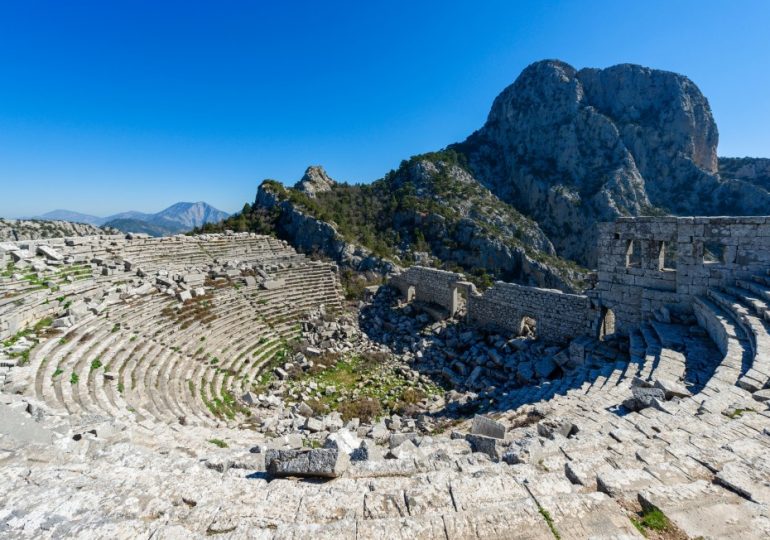A HIDDEN CITY so high up in the mountains that not even Alexander the Great could conquer lays empty.
Perched on a fortified eagles nest high in the mountains of southwestern Turkey, Termessos, can be conquered by anyone willing to make the hike up here.
AlamyTermessos was one of two cities in Asia Minor that Alexander the Great could not conquer.[/caption]
AlamyThe ancient town is littered with ancient tombs that have been broken in to[/caption]
AlamyThe once powerful city was destroyed by an earthquake, with temples left in ruins[/caption]
While easily reached by car via Antalya, the ancient wonder stands empty despite boasting majestic landscapes and historical intrigue.
The once poweful city of Termessos dates back to 334 BCE, when the ancient Macedonian king Alexander the Great attempted to conquer the 1000ft fortified mountain.
Unable to navigate the steep mountain slopes and rocky terrain, Termessos is one of two cities in Asia Minor the conquering King could not conquer.
While not much is known about the fall and destruction of Temessons, it is believed an earthquake in the 4th or 5th century CE destroyed the aqueduct which supplied drinking water to the people in the mountains.
By then, the city was completed deserted until it was discovered by modern travellers in the 19th century.
Polish researcher Karol Lanckoroński repeatedly visited the ancient wonder. In his book The Cities of Pamphylia and Pisidia, he said: ‘Of all the cities of Pisidia which we have visited, Termessos has the most peculiar and the greatest position.
“It is, at the same time, a watchtower commanding a distant view and nest buried deeply in a valley, surrounded by a ring of mountains.
“If its inhabitants indulged in brigandage, they could not find a better hiding place than in this eagle’s nest.”
Antalya-based art teacher and licensed guide, Önder Uğuz said the Romans had more success than Alexander the Great in ruling the city.
He said: “Not through force but through more insidious means, like offering autonomy under Roman protection.”
Uncovering the mountain’s hidden secrets
But it’s not just the breathtaking mountain views that make it the lost city spectacular, the mountain itself is a tomb for Termessos’ rich and mighty.
The cemeteries contain ancient sarcophagi which were carved with shields and spears for warriors.
And like most ancient burial sites, the tombs have been broken into by tomb raiders over the centuries.
They do however provide clues to the warriors who were buried there, including one early Hellenistic tomb from 4 BC believed to belong to a general under Alexander the Great.
A life-size relief of an equestrian figure with a lance and the resting bed is believed to belong Alketas, a general who ruled under the ancient conqueror.
In addition to the tombs, the once grand city featured shops in the agora – a marketplace, and a theatre – a key feature in both the Hellenic and Roman period in Termessos.
Built in the Hellenistic period, it was made of hewn stones and could seat 4,200 people.
In the Roman period, in the 2nd century AD, the theatre underwent significant alternations.
The ancient ruins also reveal the marble ruins of the city’s gymnasium for trainee soldiers, which would’ve been vital in protecting the once powerful mountain stronghold.
Like other ancient villages, Termessos was home to several temples dedicated to the gods and godesses.
Six temples remain in the ruins, with the main temple dedicated to main deity of Termessos known as Solymian Zeus.
While the temple and ruins may be isolated, tours of the site run daily, and can be reached via public transport, taxi or car from Antalya.
Who is Alexander the Great?
Born in 356 BCE at Pella in the ancient Greek kingdom on Macedon, Alexander the Great was the son of Philip II and Olympias.
He succeeded his father Philip II to the throne at the age of 20 and spent most of his ruling years conducting a lengthy military campaign throughout Western Asia, Central Asia, parts of South Asia, and Egypt.
By the age of 30, he had created one of the largest empires in history, stretching from Greece to northwestern India. The entire area from Greece in the west, north to the Danube, south into Egypt and as far to the east as the Indian Punjab, was linked together in a vast international network of trade and commerce
He was undefeated in battle and is widely considered to be one of history’s greatest and most successful military commanders.
He died of a fever in Babylon in June 323 BCE at the age of 32.
AlamySarcophagus or rock tombs line the ancient city of Termessos[/caption]
AlamyAn example of Greek Macedonian sepulchral art showing a warrior riding a horse within the 4th century BC Tomb of Alcetas at Termessos in Turkey.[/caption]
AlamyThe Ancient theatre could hold 4,200 people[/caption]
AlamyThe ancient ruins of the famous amphitheater in the ancient city of Termessos[/caption]
AlamyThe gymnasium in the ancient city of Termessos[/caption]
AlamyRuins of the ancient city of Termessos[/caption]
Leave a comment








